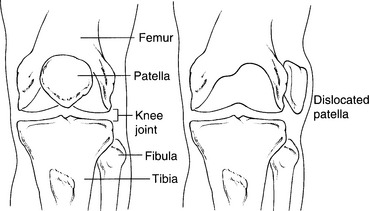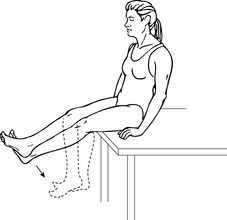Patellar Dislocation and Subluxation
Common signs and symptoms
• Numbness or paralysis below the dislocation from pinching, cutting, or pressure on the blood vessels or nerves (uncommon)
• Often, patellar dislocation to the outer side of the knee, causing an obvious deformity; often relocates on its own when the knee is straightened, leaving no deformity, however, damage is the same in both cases.
Factors that increase risk
• Participation in contact sports (football, soccer), sports that require jumping and landing (basketball, volleyball), or sports in which cleats are worn
Preventive measures
• Maintain appropriate conditioning that includes thigh, leg, and knee strength, flexibility and endurance training, and cardiovascular fitness.
• For jumping (basketball, volleyball) or contact sports, protect the patella with supportive devices, such as elastic bandages, tape, braces, knee sleeves with a hole for the patella and a built-up outer side or straps to pull the patella inward, or kneepads.
Possible complications
• Associated fracture or joint cartilage injury as a result of the dislocation or reduction (repositioning) of the patella
Medication
• Nonsteroidal antiinflammatory medications, such as aspirin and ibuprofen (do not take for 7 days before surgery), or other minor pain relievers, such as acetaminophen, are often recommended. Take these as directed by your physician, and contact your doctor immediately if any bleeding, stomach upset, or signs of an allergic reaction occur.
Heat and cold
• Cold is used to relieve pain and reduce inflammation for acute and chronic cases. It should be applied for 10 to 15 minutes every 2 to 3 hours as needed and immediately after any activity that aggravates your symptoms. Use ice packs or an ice massage.
When to call your doctor
• Any of the following signs of infection occur after surgery: fever, increased pain, swelling, redness, drainage, or bleeding in the surgical area.
Range of motion  knee flexion
knee flexion
2. Bend your knee slowly, and slide your heel toward your buttocks. Bend your knee as far as is comfortable to get a stretching sensation.
Range of motion  knee flexion/extension
knee flexion/extension
3. Flexion: Cross your ankles, placing the uninjured leg on top of the injured leg. Pull your heels backward under the surface you are sitting on to increase the bend in your knee.
< div class='tao-gold-member'>
Only gold members can continue reading. Log In or Register to continue
Stay updated, free articles. Join our Telegram channel

Full access? Get Clinical Tree










